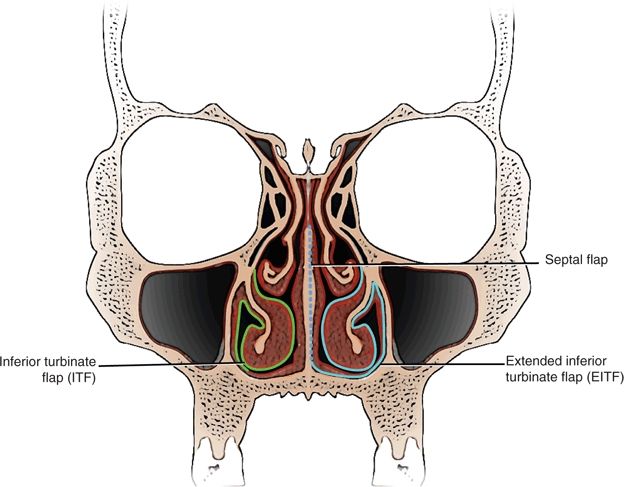Figure 44.1 Vascular anatomy of the lateral nasal wall. The inferior turbinate flap is supplied by a branch of the sphenopalatine artery that courses along the length of the inferior concha.
Several variations of the ITF are available (Fig. 44.2). A standard ITF consists of the mucosa covering the inferior concha and inferior meatus. An extended ITF (EITF) includes the mucosa of the floor of the nose. The ITF can be extended further by including the mucosa of the nasal septum. This creates a flap that is comparable in size and reach to a nasoseptal flap. The septal extension probably has a random blood supply and is at greater risk of distal ischemia than is a typical nasoseptal flap.

Figure 44.2 Variations of the inferior turbinate flap (ITF). A standard ITF consists of the mucosa covering the inferior concha and inferior meatus (green). An extended ITF (EITF) includes the mucosa of the nasal floor (blue). The EITF can be extended further by incorporating the mucosa of the nasal septum (blue dotted line).
HISTORY
It is important to inquire about prior nasal surgery including nasal septoplasty, turbinate reduction, endoscopic sinus surgery, treatment of epistaxis, and endoscopic or microscopic skull base surgery. Prior surgery may have sacrificed the vascular pedicle to the nasoseptal flap or ITF and compromised the nasal mucosa. Rarely, chronic inflammatory disease such as granulomatous disease may damage the mucosa.
PHYSICAL EXAMINATION
Nasal endoscopy includes an assessment of mucosal surfaces and integrity of the vascular pedicles. A large maxillary antrostomy that extends to the sphenopalatine foramen may have compromised the vascular supply. Similarly, a large sphenoid antrostomy with sacrifice of the posterior septal artery precludes the use of a nasoseptal flap.
Deviation of the nasal septum will make the dissection of the flap more difficult on the convex side and increases the risk of tearing the mucosa. Generally, a flap will be performed on the side of the nasal cavity with the most room for instrumentation. Increased tumor dissection on one side may necessitate using a flap where the pedicle is based on the contralateral side.
INDICATIONS
An ITF is indicated for large dural defects when a nasoseptal flap is unavailable or for coverage of exposed vascular structures (internal carotid artery). The ITF has a limited arc of rotation due to the orientation of the vascular pedicle, and the mucosa of the inferior concha does not conform well to a new surface. An EITF is used in most cases but may include a septal extension if a longer flap is needed and the septal mucosa is available. Due to the limited arc of rotation, an ITF is ideally suited for clival defects and provides optimal coverage in a horizontal orientation.
CONTRAINDICATIONS
Contraindications to the use of an ITF include the absence of a vascular pedicle (prior surgery or embolization of the internal maxillary artery) or prior resection of the inferior turbinate. Adhesions between the inferior turbinate and the nasal septum can be lysed prior to elevation of the flap. A severely deviated nasal septum is a relative contraindication and may need to be corrected to allow room for dissection. If bilateral transpterygoid approaches are necessary, exposure may be limited by the flap pedicle. In such cases, mobilization of the pedicle into the pterygopalatine space may be necessary.
A defect that is too large or distant to be completely covered by an ITF is a relative contraindication. Alternative flap reconstructions should be considered first. If the ITF is insufficient to provide complete coverage, it can be used in combination with multilayered fascial grafts. A deep clival defect may need to be filled with adipose tissue grafts deep to the flap so that the ITF can provide complete mucosal coverage. Tumor involvement of the nasal mucosa is a contraindication, especially for high-grade malignancies such as squamous cell carcinoma, adenocarcinoma, or melanoma or when final tumor margins are difficult to assess such as with adenoid cystic carcinoma.
PREOPERATIVE PLANNING
The surgical team should discuss the surgical approach, extent of exposure, and reconstructive needs prior to the surgery. Large dural defects should be reconstructed with vascularized tissues whenever possible. Every operation should have a backup plan for reconstruction if the primary reconstruction is not possible due to loss of the vascular pedicle or involvement by tumor.
Preoperative imaging of the vascular supply to the flap is not necessary. If preoperative embolization of a tumor is performed, communication with the interventional radiologist will ensure that vessels to reconstructive flaps will be preserved when feasible.
SURGICAL TECHNIQUE (VIDEO 44.1)
It is important to preserve the vascular supply to the ITF as part of the surgical approach and resection. The flap is usually harvested at the time of dural reconstruction unless the vascular pedicle is blocking access (transpterygoid approach). If the flap is elevated early in the procedure, the flap is protected by passing it through the antrostomy into the maxillary sinus. Vasoconstriction of the nasal mucosa is achieved by inserting cottonoid pledgets soaked in 0.05% oxymetazoline for several minutes and injection of local anesthetic (0.5% Xylocaine, 1:200,000 epinephrine) into the surrounding mucosa.
Standard Inferior Turbinate Flap
A generous middle meatal antrostomy is performed with removal of bone posteriorly to the sphenopalatine foramen and inferiorly to the attachment of the inferior turbinate. Care should be taken to avoid injury to the sphenopalatine artery and its branches through excessive removal of bone or electrocautery.
Stay updated, free articles. Join our Telegram channel

Full access? Get Clinical Tree


